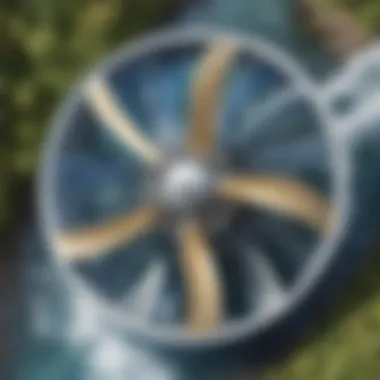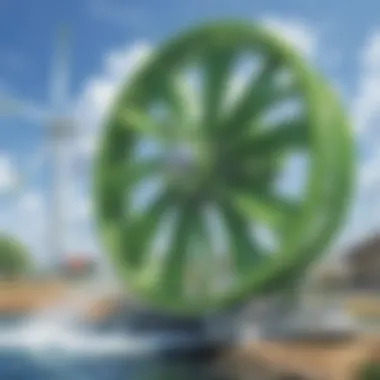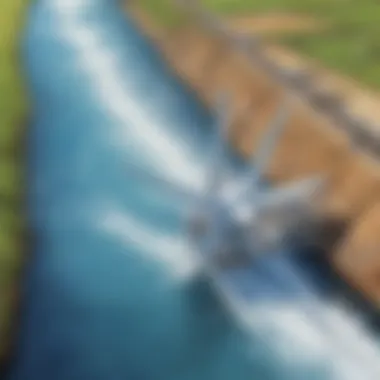Unleashing the Potential of Water: Exploring the Innovation of Water-Powered Turbines


Science Fun Facts
Water has unique properties that make it a powerful force. When channeled correctly, it can drive turbines to generate clean energy. Did you know that water is one of the most abundant resources on Earth, making it a promising source of renewable energy?
Water turbines work on a simple principle: they convert the kinetic energy of flowing water into mechanical power, which is then transformed into electricity. This process showcases the remarkable ability of nature to provide sustainable energy solutions.
Water-powered turbines have been used for centuries, dating back to ancient civilizations harnessing water wheels for various activities. Today, modern turbines have evolved to efficiently capture water's energy to meet our growing electricity demands while reducing our dependence on fossil fuels.
Discover the Wonders of Science
Examining the science behind water-powered turbines unveils fascinating concepts of energy conversion and hydrodynamics. Through educational videos and animations, one can observe how these turbines operate, highlighting the intricate relationship between water flow and energy production.
Furthermore, real-life applications of water-powered turbines in hydropower plants showcase the practicality of renewable energy sources. Understanding these applications provides insight into the role of technology in shaping a sustainable future, enticing young minds to explore the possibilities of clean energy.
Science Quiz Time
Engage in a stimulating scientific quiz to test your knowledge on water-powered turbines. Challenge yourself with multiple-choice questions that delve into the mechanics of turbine operation, encouraging critical thinking and problem-solving skills.
As you navigate brain teasers and puzzles related to renewable energy, you'll not only expand your scientific understanding but also enhance your awareness of environmental conservation. Learning through gamification offers an interactive approach to grasping complex scientific topics, making the learning experience both enjoyable and educational.
Science Experiment Showcase
Embark on a journey of discovery through interactive science experiments that demonstrate the principles behind water-powered turbines. With step-by-step instructions and a detailed materials list, you can conduct hands-on activities that simulate the process of harnessing water's energy.
Safety tips and precautions ensure a secure experimental environment, fostering a sense of responsibility and scientific curiosity. By engaging in fun and engaging experiments, you'll develop a deeper appreciation for the innovative potential of water-powered turbines, igniting a passion for sustainable technology.
Introduction
Water-powered turbines represent a groundbreaking innovation in renewable energy solutions. Harnessing the natural force of water, these turbines offer a sustainable approach to energy generation, holding immense potential for a greener future. In this section, we will delve deep into the intricacies of water-powered turbines, uncovering their impact on renewable energy sources and the role they play in shaping the energy landscape.
Understanding Water-Powered Turbines


Definition and Principles
Water-powered turbines operate on the fundamental principle of converting the kinetic energy of flowing water into mechanical energy. This conversion process is crucial in generating electricity from renewable sources. The key characteristic of this principle lies in its efficiency in harnessing a continuous and eco-friendly energy source. Despite the seasonal variability that may affect water flow, the adaptability of water-powered turbines makes them a reliable choice for sustainable energy generation.
History of Water Turbines
The history of water turbines dates back centuries, with early designs being used for various industrial applications. Over time, technological advancements have refined the efficiency and effectiveness of water turbines, making them integral to hydropower generation. The unique feature of water turbines lies in their ability to utilize a natural, abundant resource for electricity production. While challenges like ecological impact persist, the advantages of harnessing water's power for energy production cannot be understated.
Importance of Renewable Energy
Global Energy Landscape
In the global energy landscape, renewable energy sources like water-powered turbines play a vital role in diversifying the energy mix. Their ability to generate clean electricity contributes to reducing greenhouse gas emissions and addressing climate change. The key characteristic of water-powered turbines in this context is their sustainability and long-term viability as a renewable energy source. Despite challenges in infrastructure and initial investment, the unique feature of these turbines lies in their low environmental impact and energy security benefits.
Sustainability Goals
Achieving sustainability goals is imperative for a greener future, and water-powered turbines align closely with these objectives. By promoting energy diversification and reducing reliance on fossil fuels, these turbines support the transition to a more sustainable energy sector. The key characteristic of sustainability goals related to water-powered turbines is their contribution to mitigating environmental degradation and promoting energy independence. Despite potential disadvantages in terms of initial setup costs, the unique feature of sustainability goals is their long-term positive impact on the environment and society.
Design and Mechanics
In the realm of water-powered turbines, the section on Design and Mechanics stands as the cornerstone of innovation and functionality. Understanding the intricacies of how these turbines are structured and how they operate is paramount in grasping their significance in the renewable energy landscape. The design aspect encompasses a range of considerations, from the materials used to the shape and size of the turbine blades. Mechanics, on the other hand, delve into the working principles that enable the conversion of water's force into usable energy. These components work in harmony to harness the power of water effectively and efficiently, highlighting the meticulous engineering required for optimal performance.
Types of Water Turbines
Impulse Turbines
In the discussion of water turbines, the category of Impulse Turbines plays a pivotal role in energy generation. What sets Impulse Turbines apart is their unique method of converting water's kinetic energy into mechanical energy. The key characteristic of Impulse Turbines lies in the use of high-velocity water jets to rotate the turbine blades, resulting in power generation. This particular design makes Impulse Turbines a popular choice for applications requiring high efficiency and speed. Despite their advantages, Impulse Turbines do have limitations, such as the need for high water pressure for optimal performance. Understanding these nuances is crucial when considering their implementation in various settings.
Reaction Turbines
On the other end of the spectrum are Reaction Turbines, offering a distinct approach to harnessing water's power. Unlike Impulse Turbines, Reaction Turbines utilize both the kinetic energy and pressure of water to generate electricity. The key characteristic of Reaction Turbines lies in their enclosed design, allowing for the pressure of water to spin the turbine. This method makes Reaction Turbines a reliable choice for applications where a continuous flow of water is available. However, the complexity of their design and maintenance requirements can pose challenges in certain environments. Balancing these advantages and disadvantages is essential in determining the ideal turbine system for specific energy needs.


Working Mechanism
Flow of Water
Central to the operation of water-powered turbines is the Flow of Water, a critical aspect that impacts energy generation. The key characteristic of fluid dynamics dictates how water flows through the turbine system, influencing its efficiency and output. Understanding the behavior of water as it passes through the turbine blades is essential for optimizing power generation. The unique feature of controlling and directing the flow of water allows for precise energy conversion, contributing to the overall performance of the turbine system.
Generation of Power
Complementing the Flow of Water is the Generation of Power, which focuses on transforming water's energy into electrical power. The key characteristic of power generation lies in the mechanisms integrated within the turbine system that convert mechanical energy into electrical energy. This conversion process is crucial for producing sustainable electricity from renewable sources. The unique feature of power generation in water turbines is its environmental sustainability, offering a clean energy solution without harmful emissions. However, limitations such as energy storage and distribution challenges need to be addressed for widespread adoption and integration into diverse energy systems.
Applications and Benefits
Water-powered turbines play a pivotal role in the realm of renewable energy, representing a sustainable solution with immense potential for a greener future. They harness the natural force of water to generate power, offering several key advantages. These turbines excel in their ability to provide a consistent and reliable source of electricity. By efficiently converting water's kinetic energy into electrical power, they contribute significantly to reducing dependency on traditional fossil fuels. Moreover, water-powered turbines promote energy sustainability by operating with minimal environmental impact, aligning perfectly with global sustainability goals and efforts towards a cleaner energy landscape.
Hydropower Generation
Electricity Production
Electricity production through hydropower generation stands out as a cornerstone of water-powered turbines. This method involves converting water's potential and kinetic energy into electrical power, ensuring a steady supply of clean electricity. One key characteristic of this process is its scalability, allowing for power generation at various capacities to meet diverse energy demands. The unique feature of electricity production lies in its cost-effectiveness and reliability, making it a preferred choice for sustainable energy solutions. While it boasts numerous advantages such as lower operational costs and minimal greenhouse gas emissions, challenges like environmental impacts and land requirement must be carefully managed for optimal integration into the renewable energy mix.
Rural Electrification
Rural electrification, facilitated by hydropower generation, plays a vital role in extending electricity access to remote areas. This initiative addresses the energy needs of rural communities, powering homes, schools, and businesses. The key characteristic of rural electrification is its transformative impact on socio-economic development, enhancing living standards and creating opportunities for growth. A unique feature of this endeavor is its ability to bridge the energy access gap, empowering populations with a reliable and sustainable energy source. While rural electrification offers benefits like improved quality of life and enhanced productivity, challenges related to infrastructure development and affordability need to be addressed for widespread adoption.
Environmental Advantages
Reduced Carbon Footprint
Reducing the carbon footprint is a major environmental advantage associated with water-powered turbines. By generating electricity through hydropower, these turbines minimize reliance on fossil fuels, consequently lowering greenhouse gas emissions. The key characteristic of reduced carbon footprint is its significant contribution to combatting climate change, mitigating the environmental impact of energy production. A unique feature of this green energy solution is its long-term sustainability and positive effect on air quality, making it a desirable choice for environmentally conscious individuals and industries. While the advantages include mitigating climate change and promoting cleaner air, factors like ecosystem disruption and methane emissions from reservoirs pose challenges that necessitate thorough mitigation strategies.
Water Conservation


Water conservation achieved through hydropower generation illustrates another environmental advantage of water-powered turbines. This approach utilizes water resources efficiently for electricity production, promoting responsible water use. The key characteristic of water conservation is its dual benefit of producing electricity while safeguarding freshwater reserves, contributing to water resource management. A unique feature of this practice is its alignment with sustainable water usage principles, ensuring long-term availability of water for various sectors. While the benefits encompass energy-water nexus optimization and drought resilience, issues related to aquatic ecosystems and sedimentation require careful monitoring and conservation efforts to maintain environmental integrity.
Challenges and Innovations
Water-powered turbines stand at the forefront of renewable energy innovation, poised to revolutionize the energy landscape. To comprehend the pivotal nature of challenges and innovations in this domain is crucial, as it reveals the evolutionary path towards a sustainable future. The significance of enhancing efficiency in water-powered turbines lies in its ability to maximize power generation while minimizing resource utilization. This balance is not only beneficial for energy output but also for environmental conservation and operational cost reduction. Technological advancements play a pivotal role in achieving optimal efficiency levels. By integrating cutting-edge technologies, such as advanced monitoring systems and adaptive control mechanisms, water-powered turbines can operate at peak performance levels. These advancements not only streamline operations but also improve overall system reliability and longevity. However, it is essential to carefully evaluate the scalability and compatibility of these technologies to ensure seamless integration within existing infrastructure.
- Optimizing Performance: The quest for optimizing performance in water-powered turbines seeks to fine-tune the mechanisms that drive energy production. By focusing on enhancing the turbine's aerodynamic design and hydraulic efficiency, engineers can significantly boost power output while maintaining operational stability. This meticulous approach not only leads to increased energy yield but also prolongs the turbine's lifespan and reduces maintenance requirements. However, optimizing performance also poses challenges, such as ensuring harmonious interaction between varying components and adapting to fluctuating water flow rates. Despite these complexities, the rewards of optimized performance far outweigh the challenges, as it unlocks the full potential of water-powered turbines, making them a sustainable and reliable source of energy generation.
Overcoming Limitations
While water-powered turbines offer a clean and renewable energy solution, they are not without limitations. Understanding and addressing these constraints are pivotal to maximizing their efficacy and mitigating potential drawbacks. Seasonal variability presents a significant challenge to the consistent performance of water-powered turbines. Fluctuations in water flow, especially in regions prone to seasonal changes, can impact energy production levels. Implementing robust predictive models and adaptive control strategies is key to overcoming this limitation. By forecasting seasonal variations and adjusting turbine operations accordingly, operators can maintain a steady energy output throughout the year.
- Ecological Impact: The ecological footprint of water-powered turbines is a critical consideration in their adoption and expansion. While these turbines offer a green alternative to traditional energy sources, they can also exert ecological pressure on local ecosystems. It is essential to assess the ecological impact at every stage, from installation to decommissioning, to minimize adverse effects on wildlife and natural habitats. Implementing comprehensive environmental impact assessments and adopting eco-friendly practices, such as fish-friendly turbine designs, can mitigate the ecological impact significantly. Striking a balance between energy generation and environmental preservation is paramount in ensuring the long-term sustainability of water-powered turbines.
Future Prospects
In the realm of water-powered turbines, the focus is not only on its current applications but also on the untapped potential that future advancements and innovations can bring. The section on Future Prospects delves into the exciting possibilities that lie ahead for this technology. By exploring innovative applications and developments, the Future Prospects segment opens up a world of opportunities for improving efficiency, expanding usability, and integrating water-powered turbines into various sectors.
Innovative Applications
Urban Settings
Urban settings present a unique canvas for the implementation of water-powered turbines. In bustling cities, the integration of this technology holds significant promise for sustainable energy generation. One key characteristic of Urban Settings is the dense population, which provides a constant flow of water usage that can be capitalized on by turbines. The positioning of turbines strategically within urban landscapes can optimize energy capture and utilization. Despite slight limitations due to space constraints, the advantages of utilizing Urban Settings for water-powered turbines outweigh the challenges. The reliable water flow in urban areas ensures a consistent energy output, making it a desirable choice for expanding the reach of renewable energy sources.
Industrial Sectors
Industrial sectors play a pivotal role in the adoption of water-powered turbines for energy generation. The Industrial Sectors offer vast opportunities for scaling up the use of this technology. One key characteristic of Industrial Sectors is the high energy demand, making the integration of water-powered turbines a beneficial choice for meeting these requirements sustainably. The unique feature of Industrial Sectors lies in their ability to customize turbine setups to align with specific production needs, enhancing operational efficiency. While challenges such as initial setup costs may be a drawback, the advantages of long-term cost savings and reduced environmental impact make the adoption of water-powered turbines in Industrial Sectors a prudent investment.
Technological Advancements
Smart Grid Integration
Smart Grid Integration plays a crucial role in maximizing the efficiency and effectiveness of water-powered turbines within the energy grid. One key characteristic of Smart Grid Integration is its capability to regulate power flow in real-time, ensuring optimal utilization of energy generated by turbines. This feature makes it a popular choice for enhancing grid stability and balancing energy loads. The unique feature of Smart Grid Integration is its ability to diversify energy sources and incorporate renewable sources seamlessly. While there may be challenges related to compatibility with existing infrastructure, the advantages of improved grid resilience and reduced carbon emissions outweigh any initial hurdles.
Hybrid Energy Systems
Hybrid Energy Systems represent a cutting-edge approach to combining multiple sources of energy, including water-powered turbines. One key characteristic of Hybrid Energy Systems is their versatility in adapting to varying energy demands and sources. This flexibility makes them a beneficial choice for optimizing energy utilization and storage. The unique feature of Hybrid Energy Systems is their ability to switch between different energy sources based on efficiency and availability, ensuring a reliable power supply. While complexities in system design and integration may pose challenges, the advantages of improved energy security and sustainability make Hybrid Energy Systems a promising avenue for future energy infrastructure.







